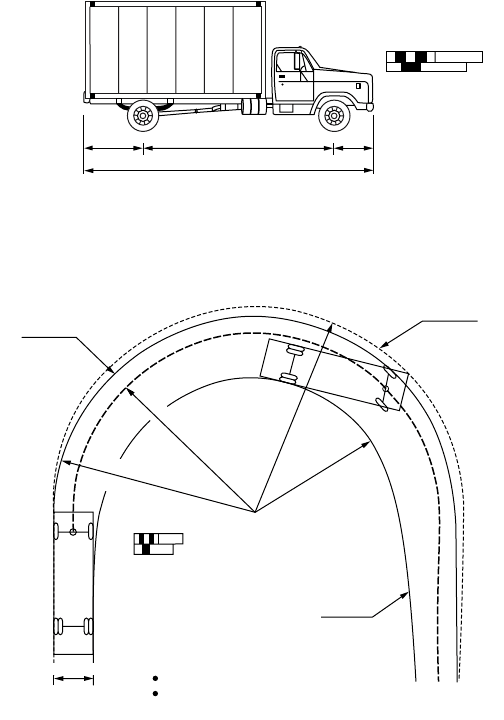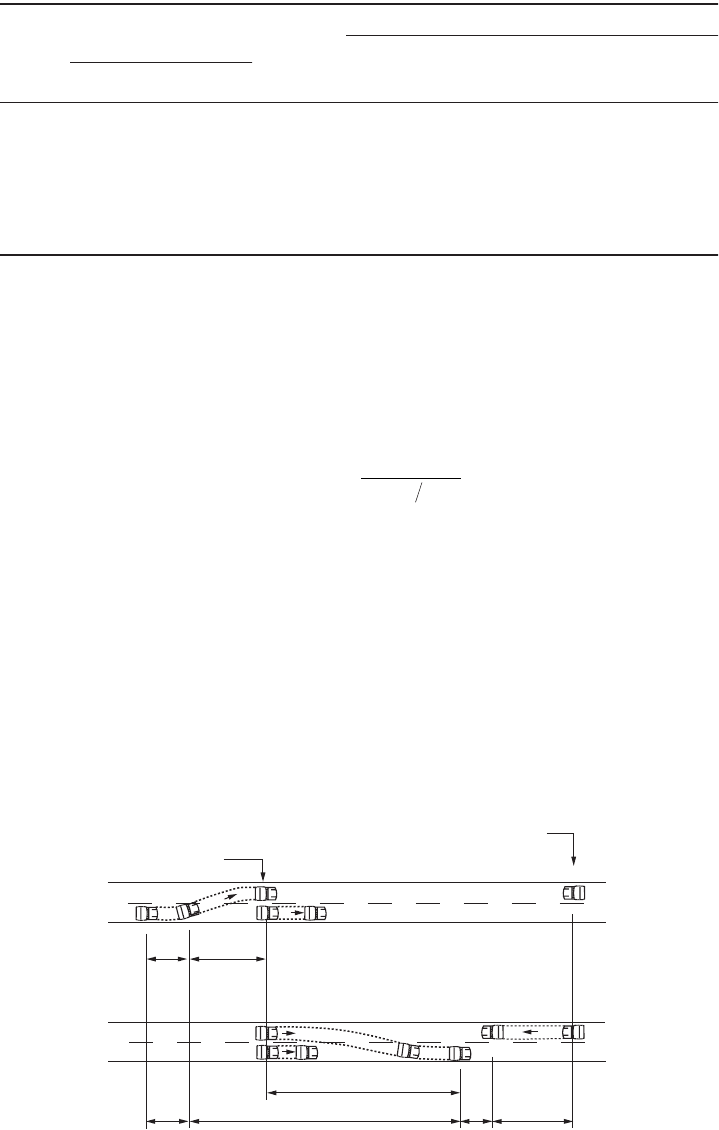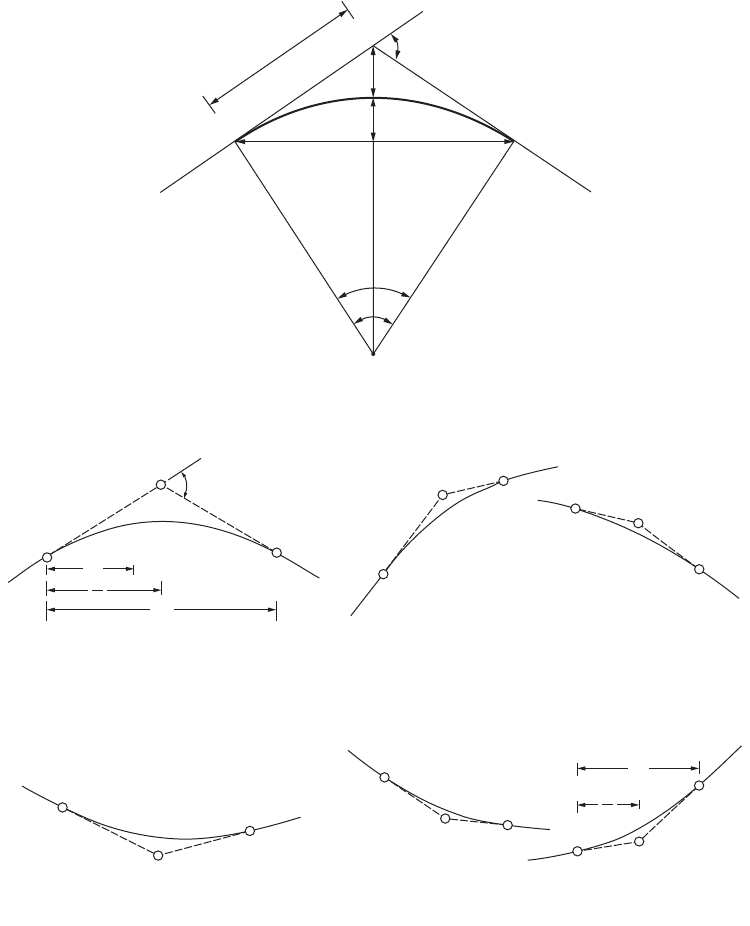Wai-Fah Chen.The Civil Engineering Handbook
Подождите немного. Документ загружается.


63
-2
The Civil Engineering Handbook, Second Edition
Design Process
The design process of a proposed highway involves preliminary location study, environmental impact
evaluation, and final design. This process normally relies on a team of professionals, including engineers,
planners, economists, sociologists, ecologists, and lawyers. Such a team may have responsibility for
addressing social, environmental, land-use, and community issues associated with highway development.
Preliminary Location Study
The preliminary location study involves collecting and analyzing data, locating feasible routes, determin-
ing preliminary horizontal and vertical alignments for each, and evaluating alternative routes to select
the best route. The types of data required are related to the engineering, social and demographic,
environmental, and economic characteristics of the area. Examples of such data are topography, land-
use pattern, wildlife types, and unit costs of construction. A preliminary study report is prepared and
typically includes a general description of the proposed highway, a description of alternative locations
and designs, projected traffic volumes and estimated total costs, an economic and environmental eval-
uation, and a recommended highway location. Before the project is approved, it is common to hold
public hearings to discuss the preliminary study and environmental impacts.
Environmental Evaluation
Highway construction may impact the environment in a number of areas, including air quality, water
quality, noise, wildlife, and socioeconomics. For example, highways may cause loss or degradation of a
unique wildlife habitat and changes to migratory patterns. Socioeconomic impacts include displacement
of people and businesses, removal of historically significant sites, and severance of the interpersonal ties
of displaced residents to their former community. It is therefore essential that environmental impacts of
alternative highway locations be fully evaluated.
Provisions of the National Environment Policy Act of 1969 require that an environmental impact
statement (EIS) be submitted for any project affecting the quality of the environment. The EIS must
describe the environmental impacts of the proposed action, both positive and negative; probable unavoid-
able adverse environmental impacts; secondary environmental impacts such as changes in the pattern of
social and economic activities; analysis of short- and long-term impacts; irreversible and irretrievable
commitments of resources; and public and minority involvement. Chapter 8, Section 10, provides more
details on the environmental process.
Final Design
The final design involves establishing the design details of the selected route, including final horizontal
and vertical alignments, drainage facilities, and all items of construction. The design process has been
revolutionized by advanced photogrammetric and computer techniques. For example, designers now can
have a driver’s eye view of a proposed highway alignment displayed on a monitor and readily examine
the effects of alignment refinements. Further details on the design process are found in Garber and Hoel
[2001].
63.2 Fundamentals of Geometric Design
Geometric design involves a number of fundamentals and concepts that guide and control the manner
in which a highway is designed. These include highway types, design controls, sight distance, and simple
highway curves.
Highway Types
Classification of highways into functional classes is necessary for communication among engineers,
administrators, and the general public. The functional classification system facilitates grouping roads
that require the same quality of design, maintenance, and operation. The system also facilitates the logical
© 2003 by CRC Press LLC
Geometric Design
63
-3
assignment of responsibility among different jurisdictions, and its structure of the design guidelines is
readily understood.
The highway functional classes, adopted separately for urban and rural areas, are locals, collectors,
and arterials. The principal arterial system includes freeways and other principal arterials. The two major
considerations in the functional classification system are travel mobility and land access. Locals emphasize
the land access function; collectors provide a balanced service for both functions; and arterials emphasize
the mobility function. Design guidelines for locals, collectors, arterials, and freeways, in both urban and
rural locations, are presented by AASHTO in Chapters 5 through 8, respectively. Details on functional
system characteristics are found in FHWA [1989].
Design Controls
The major controls that influence the geometric design of highways include topography, the design
vehicle, driver performance, traffic characteristics, highway capacity, access control and management, the
pedestrian, bicycle facilities, and safety. Other controls such as esthetics, environment, economics, and
public concerns are important but are reflected in either the preceding major controls or the preliminary
location study.
Design Vehicle
A design vehicle is a vehicle with representative weight, physical dimensions, and operating characteristics,
used to establish highway design controls for accommodating vehicles of designated classes. Each design
vehicle has larger dimensions and a larger minimum turning radius than most vehicles in its class. Four
general classes of design vehicles have been established: passenger cars, buses, trucks, and recreational
vehicles. The dimensions of 20 design vehicles within these general classes are given by AASHTO. The
design vehicle selected for geometric design is the largest vehicle likely to use the highway with consid-
erable frequency or a vehicle with special characteristics appropriate to a particular intersection for
determining the radii at intersections and the radii of
turning roadways
. A typical minimum turning
path for a single-unit (SU) truck design vehicle is shown in Fig. 63.1. Other vehicle characteristics such
as acceleration and braking capabilities, the driver’s eye height, and vehicle headlights also affect many
geometric design features.
Driver Performance
Highways should be designed to be compatible with driver capabilities and limitations. Information
about the performance of the drivers (how they interact with the highway and its information) is useful
in highway design and operations. Since it is not generally possible to reduce errors caused by innate
driver deficiencies, a “forgiving” design that lessens the consequences of failure should be implemented.
In addition, a positive guidance approach should be applied to design. Here are some examples:
•The design should focus a driver’s attention on the safety-critical elements by providing clear sight
lines and good visual quality.
•The design should take into account the longer reaction time required for complex decisions by
providing adequate decision sight distance.
• On high-speed facilities, guidance activities should be simplified because speed reduces the visual
field, restricts peripheral vision, and limits the time available to process information.
Another important means to aid driver performance is the development of designs in accordance with
driver expectancies. Detailed information on driver attributes, driving tasks, and information handling
can be found in the FHWA report
A User’s Guide to Positive Guidance
[Alexander and Lunenfeld, 1990].
Traffic Characteristics
Tr affic characteristics include traffic volume, directional distribution, traffic composition, and speed.
Design volume and composition determine the highway type, required roadway width, and other geometric
© 2003 by CRC Press LLC

63
-4
The Civil Engineering Handbook, Second Edition
features. The basic measure of the traffic demand for a highway is the
average daily traffic
(ADT). This
measure is used for selecting geometric design guidelines for local and collector roads. For other highways,
the design hourly volume (DHV), a two-way volume, is used and is generally defined as the
30th highest
hour volume
of a designated year. The ratio of the DHV and ADT,
P
, varies only slightly from year to
year. For design of a new highway,
P
can be determined using existing traffic volumes of similar highways.
The typical range of
P
is 12 to 18% for rural highways and 8 to 12% for urban highways.
For two-lane highways, the DHV is the total traffic in both directions. For multilane highways, the
directional distribution of traffic during the design hour should be determined. The directional DHV
can then be calculated by multiplying ADT by
P
and then by the percentage of traffic in the peak direction
during the design hour. For recreational routes, in practice the DHV is selected as 50% of the volume
expected to occur during the few highest hours of the design year. Other volume characteristics required
for the design year include
peak-hour factor
and the percentages of trucks, buses, and recreational vehicles
in the design-hour volume.
Design speed is a selected speed used to determine various geometric design features of the roadway.
Selection of design speed is influenced by topography, adjacent land use, highway functional classification,
and anticipated
operating speed
. Nearly all geometric design elements are directly or indirectly influenced
by design speed.
FIGURE 63.1
Minimum turning path for single-unit (SU) truck design vehicle. (From AASHTO,
A Policy on
Geometric Design of Highways and Streets
, Washington, D.C., 2001. With permission.)
Path of left
front wheel
Path of front
overhang
8.64 m min.
[28.3 ft]
13.26 m max.
[43.5 ft]
Assumed steering angle is 31.7°
CTR = Centerline turning
radius at front axle
Path of right
rear wheel
Scale
0
0
5 ft
10 ft
2.5 m
1.83 m
9.15 m
6.10 m
1.22 m
0
0
5 ft 10 ft
1 m
2.5 m
Scale
[8 ft]
[30 ft]
[20 ft]
[6 ft]
[4 ft]
Min. turning
radius = 12.80 m [42 ft]
2.44 m
CTR = 11.58 m [38 ft]
© 2003 by CRC Press LLC

Geometric Design
63
-5
Highway Capacity
The required number of lanes of a highway depends on the DHV and the
level of service
intended for
the design year. The
Highway Capacity Manual
[TRB, 2000] defines six levels of service ranging from
level-of-service A (least congested) to level-of-service F (most congested). Table 63.1 shows the AASHTO-
recommended design levels of service for different highway classes and locations. These levels of service
are based on criteria for acceptable degrees of congestion.
Access Control and Management
Access control refers to the interference regulations of public access rights to and from properties on the
roadside. These regulations include full control of access, partial control of access, and access manage-
ment. Full-controlled access facilities (such as freeways) have no at-grade crossings and have access
connections only with selected roads. With partial control of access, preference is given to through traffic
to an extent, but there may be some at-grade crossings and driveway connections. Partial access control
can be achieved by driveway permits, zoning restrictions, and frontage roads. The extent of access control
is a significant factor in defining the functional type of a highway.
Access management, a new element of road design that applies to all types of roads, involves providing
(managing) access to land development while simultaneously preserving the flow of traffic (safety,
capacity, and speed) on the surrounding road system. It views the roadway and its surrounding activities
as part of a system with the goal of coordinating the planning and design of each activity. For more
details on access management, see Koepke and Levinson [1992].
Pedestrian
Interaction of pedestrians with traffic is a major consideration in highway planning and design. Pedestrian
facilities include sidewalks, crosswalks, curb ramps for the handicapped, and grade separations. Sidewalks
are usually provided in urban areas and in rural areas with high pedestrian concentrations, such as schools,
local businesses, and industrial plants. Pedestrian crosswalks are provided at intersections and at midblocks.
For guidance on pedestrian crosswalk marking, refer to the
Manual on Uniform Traffic Control Devices
(MUTCD). Curb ramps for the handicapped should be provided at all intersections that have curbs and
sidewalks and at midblock pedestrian crossings. Because these crossings are generally unexpected by
drivers, warning signs and adequate visibility should be provided. Pedestrian grade separations are nec-
essary when pedestrian and traffic volumes are high or where there is abnormal inconvenience to pedes-
trians, such as at freeways. Design issues on safe accommodation of pedestrians are addressed in the
AASHTO
Guide for the Planning, Design, and Operation of Pedestrian Facilities
[AASHTO, 2002].
Bicycle Facilities
Design of bicycle facilities is an important consideration in highway design. Design measures to enhance
safety for bicycle traffic on existing highways include paved shoulders, wider outside traffic lanes, adjust-
ment of manhole covers to pavement surface, and provision of a smooth riding surface. The highway
TABLE 63.1
Guidelines for Selection of Design Levels of Service
Appropriate Level of Service for Specified
Combinations of Area and Terrain Type
Functional
Class
Rural
Level
Rural
Rolling
Rural
Mountainous
Urban and
Suburban
Freeway
Arterial
Collector
Local
B
B
C
D
B
B
C
D
C
C
D
D
C
C
D
D
Source: American Association of State Highway and Transportation
Officials,
A Policy on Geometric Design of Highways and Streets
, Wash-
ington, D.C., 2001. With permission.
© 2003 by CRC Press LLC

63
-6
The Civil Engineering Handbook, Second Edition
system can also be supplemented by providing specifically designated bikeways. Important elements of
bikeway design include design speed, bikeway width, superelevation, turning radii, grade, stopping sight
distance, and vertical curves. The
Guide for the Development of New Bicycle Facilities
[AASHTO, 1999],
in conjunction with the MUTCD [FHWA, 1988], provides guidance for bikeway planning and design.
Safety
Safety is a major consideration in the design of nearly all elements of highway geometric design, including
horizontal and vertical alignments, cross sections, roadsides, traffic control devices, and intersections.
Safety must be reflected not only in new highway and major reconstruction projects but also in the
resurfacing, restoration, and rehabilitation (RRR) projects. AASHTO stresses the importance of estab-
lishing a safety evaluation program to identify safety hazards, evaluate the effectiveness of alternative
improvements, and allocate available funds to the most effective uses. The TAC guide includes explicit
evaluation of safety (collision frequency–design parameter relationships) for some highway elements,
such as horizontal alignment, vertical alignment, and truck climbing lanes [TAC, 1999].
Sight Distance
Sight distance is the length of the roadway ahead that is visible to the driver. It is a fundamental design
element in the safe and efficient operation of a highway. Five basic types of sight distances must be
considered in design: (1) stopping sight distance (SSD), applicable on all highways; (2) passing sight
distance (PSD), applicable only on two-lane highways; (3) decision sight distance (DSD), needed at
complex locations; (4) preview sight distance (PVSD), applicable to horizontal curves, especially those
combined with vertical curves; and (5) intersection sight distance (ISD), needed for all types of inter-
sections. In addition, a special type of sight distance (called head-on sight distance) that may be needed
when parking occurs on both sides of a residential street has been addressed by Gattis [1991].
Stopping Sight Distance
Stopping sight distance is the distance that enables a vehicle traveling at or near the design speed to stop
before reaching a stationary object in its path. The SSD in feet is computed by
(63.1)
where
t
= the brake reaction time (sec)
V
= the design speed (mph)
a
= the deceleration rate (ft/sec
2
)
G
= the percent of grade divided by 100 (positive for upgrade and negative for downgrade)
The recommended design criterion for brake reaction time is 2.5 sec, which exceeds the 90th percentile
of reaction time for all drivers. The recommended design deceleration rate is 11.2 ft/sec
2
, which is the
comfortable deceleration rate for most drivers on wet surfaces. Design values of SSD for level grades
(
G
= 0) are shown in Table 63.2. These values are used for such application as vertical curve design,
intersection geometry, and placement of traffic control devices. In Canada, SSD is based on the coefficient
of friction between the tires and the roadway (rather than deceleration rate) and assumed operation
speed range for each design speed [TAC, 1999].
The SSD values of Table 63.2 are based on passenger car operation and do not explicitly consider truck
operation. Trucks need longer stopping distances than passenger cars. However, truck drivers can see
substantially farther beyond vertical obstruction than passenger cars, and this factor tends to balance the
additional braking lengths required for trucks. Therefore, separate SSD values for trucks and passenger
cars are not generally used in highway design. One exception is the case of horizontal sight restrictions,
where the greater eye height of truck driver is of little value. For this case, it is desirable to provide an
SSD that exceeds the values of Table 63.2.
SSD Vt
V
aG
=+
()
+
[]
147
30 32 2
2
.
.
© 2003 by CRC Press LLC

Geometric Design
63
-7
Example 63.1
Compute the SSD for a highway with a 60-mph design speed and G = 0. From Eq. (63.1),
which is the same as the computed value in Table 63.2.
Passing Sight Distance
Passing sight distance is the distance required for a vehicle to overtake a slower moving vehicle safely on
a two-lane highway. The AASHTO model is based on certain assumptions for traffic behavior and
considers PSD as the sum of four distances (Fig. 63.2): (1) distance during perception and reaction time,
and during the initial acceleration of the passing vehicle to the encroachment point on the left lane (
d
1
);
(2) distance traveled while the passing vehicle occupies the left lane (
d
2
); (3) distance between the passing
vehicle at the end of its maneuver and the opposing vehicle (
d
3
); and (4) distance traversed by an opposing
TABLE 63.2
Design Requirements for Stopping and Passing Sight Distances
Design
Speed
(mph)
Design
Speed
(mph)
Passing Sight Distance (ft)
Passed
Vehicle Speed
(mph)
Passing
Vehicle Speed
(mph) Calculated
b
Design
Stopping Sight Distance (ft)
Calculated
a
Design
20
30
40
50
60
70
80
111.9
196.7
300.6
423.8
566.0
727.6
908.3
115
200
305
425
570
730
910
20
30
40
50
60
70
80
18
26
34
41
47
54
58
28
36
44
51
57
64
68
707
1088
1470
1832
2133
2479
2677
710
1090
1470
1835
2135
2480
2680
a
Values are calculated using Eq. (63.1).
b
Values are based on Fig. 63.3.
Source: American Association of State Highway and Transportation Officials,
A Policy on Geometric Design of
Highways and Streets
, Washington, D.C., 2001. With permission.
FIGURE 63.2
Elements of passing sight distance for two-lane highways. (From AASHTO,
A Policy on Geometric
Design of Highways and Streets
, Washington, D.C., 2001. With permission.)
SSD =¥¥+
()
()
=147 25 60
60
30 11 2 32 2
566 0
2
..
..
.ft
FIRST PHASE
SECOND PHASE
Passing vehicle
Opposing vehicle appears
when passing vehicle
reaches point A.
d
1
d
1
d
3
d
4
1/3 d
2
d
2
2/3 d
2
B
A
© 2003 by CRC Press LLC

63
-8
The Civil Engineering Handbook, Second Edition
vehicle for two-thirds of the time the passing vehicle occupies the left lane (
d
4
). The calculations of d
1
through
d
4
are described in AASHTO, and the sum of the four elements is shown in Fig. 63.3.
The design values of PSD are shown in Table 63.2. The speed of the passed vehicle is assumed to be
the
average running speed
, while the speed of the passing vehicle is 10 mph greater. The design values
apply to a single passing only. For passing maneuvers on upgrades, the passing sight distance should be
greater than the design values shown in Table 63.2. However, specific adjustments for design use are
currently unavailable.
Decision Sight Distance
Decision sight distance is required at complex locations to enable drivers to maneuver their vehicles safely
rather than stop. It is the distance required for a driver to detect an unexpected hazard, recognize the
hazard, decide on proper maneuvers, and execute the required action safely. Examples of complex
locations where provision of DSD is desirable include complex interchanges and intersections, toll plazas,
lane drops, and areas where sources of information (such as signs, signals, and traffic control devices)
compete. Design values for DSD, based on empirical data, are shown in Table 63.3. Since decision sight
distance affords drivers sufficient length to maneuver their vehicles, its value is much greater than the
stopping sight distance.
The decision sight distance is computed by
(63.2)
(63.3)
where
t
= the premaneuver time for maneuvers A and B or the total premaneuver and maneuver
time for maneuvers C to E (sec), based on the notes in Table 63.3
V
= the design speed (mph)
a
= the deceleration rate (ft/sec
2
)
Note that for maneuvers A and B in Table 63.3, the premaneuver time is increased above that of SSD
(2.5 sec) to allow the driver additional time to detect and recognize the roadway and traffic environment,
identify alternative maneuvers, and initiate a response at critical locations. The braking distance from
the design speed is then added to the premaneuver component, as noted in Eq. (63.2). For maneuvers
C to E, the braking component is replaced with a maneuver distance based on maneuver times between
FIGURE 63.3 Total passing sight distance and its components — two-lane highways. (From AASHTO, A Policy on
Geometric Design of Highways and Streets, Washington, D.C., 2001. With permission.)
d
2
d
1
d
3
d
4
Total = d
1
+ d
2
+ d
3
+ d
4
10 20
30
40 6050 70 9080
Average speed - Passing vehicle (mph)
3500
2500
3000
2000
1500
0
1000
500
Elements - Passing sight distance (ft)
DSD for maneuvers A and B=+
()
()
147 1075
2
..Vt V a
DSD for maneuvers C, D, and E=
()
147. Vt
© 2003 by CRC Press LLC

Geometric Design 63-9
3.5 and 4.5 sec that decrease with increasing speed. Where it is not feasible to provide DSD, designers
should move the location or use suitable traffic control devices to provide advance warning of the
conditions to be encountered.
Preview Sight Distance
Preview sight distance is the distance required by a driver to perceive a horizontal curve and properly
react to it. AASHTO implicitly recognizes PVSD by recommending that sharp horizontal curvature should
not be introduced at or near the top of a pronounced crest vertical curve or near the low point of a
pronounced sag vertical curve. The preview sight distance has been suggested by Gattis and Duncan
[1995] for horizontal curves. For three-dimensional alignments, PVSD is the sum of two components
(Fig. 63.4): the tangent component, S
1
, and the curve component, S
2
[Hassan and Easa, 2000]. The tangent
component is the distance required for the driver to react and adjust the speed before reaching the curve.
The curve component is the distance on the horizontal curve required for the driver to detect its existence.
Preliminary design values of PVSD have been established.
Intersection Sight Distance
Intersection sight distance is the distance provided at an intersection to allow approaching vehicles (at
an uncontrolled or yield-controlled intersection) to see any potentially conflicting vehicles in sufficient
time to slow or stop safely and to allow stopped vehicles (at a stop or signal-controlled intersection) to
enter or cross the intersection safely. Details on the calculation of intersection sight distance are presented
later in this chapter.
Design Heights for Sight Distances
The AASHTO design driver’s eye height and object height used for measuring various sight distances are
shown in Table 63.4. Sight distances are measured from a 3.5-ft driver’s eye height to a 2.0-ft object height
for SSD and DSD and a 3.5-ft object height for PSD and ISD. The object height of 3.5 ft is based on a
design vehicle height of 4.35 ft, less an allowance of 10 in. to allow another driver to recognize the vehicle
TABLE 63.3 Design Requirements for Decision
Sight Distance
Design
Speed
(mph)
Decision Sight Distance (ft)
Avoidance Maneuver
AB C D E
30
40
50
60
70
80
220
330
465
610
780
970
490
690
910
1150
1410
1685
450
600
750
990
1105
1260
535
715
890
1125
1275
1455
620
825
1030
1280
1445
1650
Avoidance maneuvers:
A: Stop on rural road (t = 3.0 sec)
B: Stop on urban road (t = 9.1 sec)
C: Speed, path, or direction change on rural road
(t varies from 10.2 to 11.2 sec)
D: Speed, path, or direction change on suburban
road (t varies from 12.1 to 12.9 sec)
E: Speed, path, or direction change on urban road
(t varies from 14.0 to 14.5 sec)
Source: American Association of State Highway and
Tr ansportation Officials, A Policy on Geometric Design
of Highways and Streets, Washington, D.C., 2001. With
permission.
© 2003 by CRC Press LLC

63-10 The Civil Engineering Handbook, Second Edition
as the object. In Canada, sight distances are measured from a 1.05-m driver’s eye height to an appropriate
object height for SSD, depending on the prevailing conditions used (ranging from 0 to 0.38 m), a 0.15-m
object height for DSD, and a 1.3-m object height for PSD [TAC, 1999]. For PVSD, a 1.05-m driver’s eye
height (daytime) or a 2-ft vehicle’s headlight height (nighttime) and a zero object height have been
recommended [Hassan and Easa, 2000].
Simple Highway Curves
Two basic curves are used for connecting straight (tangent) roadway sections in geometric design: a
simple circular curve for horizontal alignment and a simple parabolic curve for vertical alignment. Other
options include spirals, compound curves, and reverse circular curves for horizontal alignment; and
unsymmetrical curves and reverse parabolic curves for vertical alignment. Details on the geometry of
these curves can be found in Meyer and Gibson [1980].
Simple Horizontal Curves
A simple horizontal curve with radius R and deflection angle I is shown in Fig. 63.5. The basic elements
required for laying out a horizontal curve are tangent distance T, external distance E, middle ordinate
M, length of chord C, and curve length L. These elements can be easily computed in terms of R and I.
For example, the tangent distance T equals R tan (I/2) and the curve length L equals R I
p
/180. The
horizontal curve can also be described by the degree of curve (D = 5730/R, where D is in degrees and
R is in feet), instead of the radius. However, the degree of curve is no longer used in current geometric
design guides.
FIGURE 63.4 Illustration of preview sight distance. (From Hassan, Y. and Easa, S.M., J. Transp. Eng. ASCE, 126, 13,
2000.)
TA BLE 64.4
Design Heights for Daytime Sight Distances
Sight Distance
Type
Driver’s Eye Height, H
e
(ft)
Object Height, H
o
(ft)
SSD
DSD
PSD
PVSD
ISD
3.5
3.5
3.5
3.5
3.5
2.0
2.0
3.5
0
3.5
BVC
PC (or TS)
PT (or ST)
EVC
(a) Vertical Alignment
(b) Horizontal Alignment
PVSD origin
(driver eye or
vehicle headlight)
PVSD object
(pavement marking)
PVSD
S
1
S
1
S
2
S
2
© 2003 by CRC Press LLC

Geometric Design 63-11
Simple Vertical Curves
Vertical curves are normally parabolic. A simple vertical curve may be a crest vertical curve or sag vertical
curve, as illustrated in Fig. 63.6. In this figure, G
1
and G
2
are the grades of the first and second tangents
(in percent), A is the absolute value of the algebraic difference in grades (in percent), L is the curve length
measured in a horizontal plane, VPI is the vertical point of intersection, VPC is the vertical point of
curvature, and VPT is the vertical point of tangent. For a simple vertical curve, VPI lies in the middle of
the curve. The vertical curve parameter, K, is defined as (with L in feet and A in percent)
FIGURE 63.5 Geometry of simple horizontal curves.
FIGURE 63.6 Types of vertical curves. (From AASHTO, A Policy on Geometric Design of Highways and Streets,
Washington, D.C., 2001. With permission.)
PT
I
O
R
PC
I
PI
E
M
C
L
T
I/2I/2
G
2
+G
2
G
2
G
1
G
1
+G
2
+G
1
+G
1
G
2
+G
2
G
1
+G
1
(a) Crest Vertical Curves
(b) Sag Vertical Curves
TYPE I
TYPE III
TYPE II
TYPE IV
L
L
2
VPC
VPI
x
A
L
L
2
VPT
© 2003 by CRC Press LLC
